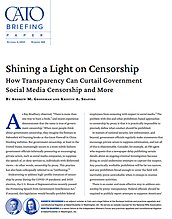1. Ray Bradbury, Fahrenheit 451 (New York: Simon & Schuster, 2013), p. 209.
2. Will Duffield, “Jawboning against Speech: How Government Bullying Shapes the Rules of Social Media,” Cato Institute Policy Analysis no. 934, September 12, 2022, p. 2.
3. H.R. Rep. No. 118–5, at 4 (March 2, 2023); and H.R. 140, 118th Cong. (2023).
4. H.R. 140, 118th Cong. § 2 (2023).
5. Louis D. Brandeis, Other People’s Money and How the Bankers Use It (Washington: Jacket Library, 1933), p. 62.
6. Will Duffield, “Jawboning against Speech: How Government Bullying Shapes the Rules of Social Media,” Cato Institute Policy Analysis no. 934, September 12, 2022, p. 2.
7. Seth F. Kreimer, “Censorship by Proxy: The First Amendment, Internet Intermediaries, and the Problem of the Weakest Link,” University of Pennsylvania Law Review 155, no. 14 (2006): 11.
8. Will Duffield, “Jawboning against Speech: How Government Bullying Shapes the Rules of Social Media,” Cato Institute Policy Analysis no. 934, September 12, 2022, p. 9.
9. H.R. Rep. No. 118–5, at 4 (2023).
10. Robby Soave, “How the CDC Became the Speech Police,” Reason Magazine, March 2023.
11. H.R. Rep. No. 118–5, at 4 (2023).
12. Ken Klippenstein and Kee Fang, “Truth Cops: Leaked Documents Outline DHS’s Plans to Police Disinformation,” The Intercept, October 31, 2022.
13. Will Duffield, “Jawboning against Speech: How Government Bullying Shapes the Rules of Social Media,” Cato Institute Policy Analysis no. 934, September 12, 2022, p. 5.
14. Seth F. Kreimer, “Censorship by Proxy: The First Amendment, Internet Intermediaries, and the Problem of the Weakest Link,” University of Pennsylvania Law Review 155, no. 14 (2006): 31.
15. National Rifle Association v. Vullo, 49 F.4th 700, 706 (2nd Cir. 2022).
16. Frank Keating, “Operation Choke Point Reveals True Injustices of Obama’s Justice Department,” The Hill (blog), November 7, 2018.
17. Josh Blackman, Unraveled: Obamacare, Religious Liberty, and Executive Power (New York: Cambridge University Press, 2016), p. 356.
18. Bantam Books, Inc. v. Sullivan, 372 U.S. 58 (1963).
19. Bantam Books, Inc. v. Sullivan, 372 U.S. 58, 61 (1963).
20. Bantam Books, Inc. v. Sullivan, 372 U.S. 58, 62 (1963).
21. Bantam Books, Inc. v. Sullivan, 372 U.S. 58, 62 (1963).
22. Bantam Books, Inc. v. Sullivan, 372 U.S. 58, 66 (1963); and Bantam Books, Inc. v. Sullivan, 372 U.S. 58, 72 (1963).
23. Bantam Books, Inc. v. Sullivan, 372 U.S. 58, 76 (1963).
24. Trump v. Twitter Inc., 602 F. Supp. 3d 1213, 1225 (N.D. Cal. 2022); and Trump v. Twitter Inc., 22–15691 (9th Cir.).
25. Backpage.com, LLC v. Dart, 807 F.3d 229, 44 Media L. Rep. 1104 (7th Cir. 2015) (quotation marks omitted).
26. Backpage.com, LLC v. Dart, 807 F.3d 229, 44 Media L. Rep. 1104 at 231–232 (7th Cir. 2015).
27. Missouri v. Biden, 2023 WL 2578260, at *30 (W.D. La. March 20, 2023).
28. Missouri v. Biden, 2023 WL 2578260, at *30 (W.D. La. March 20, 2023).
29. Judgment, at 4, ECF No. 294, Missouri v Biden, Case No. 3:22-cv-01213 (W.D. La. July 4, 2023).
30. Judgment, at 5–6, ECF No. 294, Missouri v Biden, Case No. 3:22-cv-01213 (W.D. La. July 4, 2023).
31. Missouri v. Biden, 2023 WL 4335270, at *51 (W.D. La. July 4, 2023).
32. Missouri v. Biden, 2023 WL 5821788, at *30 (5th Cir. September 8, 2023).
33. National Rifle Association v. Vullo, 49 F.4th 700, 716 (2d Cir. 2022).
34. National Rifle Association v. Vullo, 49 F.4th 700, 717 (2d Cir. 2022).
35. O’Handley v. Weber, 62 F.4th 1145 (9th Cir. 2023).
36. O’Handley v. Weber, 62 F.4th 1145, 1154 (9th Cir. 2023).
37. O’Handley v. Weber, 62 F.4th 1145, 1157 (9th Cir. 2023).
38. H.R. 140, 118th Cong. (2023).
39. H.R. 140, 118th Cong. § 2 (2023).
40. Genevieve Lakier, “Informal Government Coercion and the Problem of ‘Jawboning,’ ” Lawfare (blog), July 26, 2011.
41. Will Duffield, “Jawboning against Speech: How Government Bullying Shapes the Rules of Social Media,” Cato Institute Policy Analysis no. 934, September 12, 2022, p. 24.
42. Dustin Volz, “DHS Folds Disinformation Board after Criticism over Threat to Free Speech,” Wall Street Journal, August 25, 2022.
43. Natalie Andrews, “Republicans Intensify Calls for Investigation of Twitter after Disclosures of Internal Documents,” Wall Street Journal, December 12, 2022.
44. Trump v. Twitter Inc., 602 F. Supp. 3d 1213, 1224 (N.D. Cal. 2022); and Association of American Physicians & Surgeons, Inc. v. Schiff, 23 F.4th 1028, 1034 (D.C. Cir. 2022).
45. Michael McConnell, “Why Are Government Social Media Takedown Requests Secret? Make Them Public,” Washington Post, July 7, 2023.
46. Michael McConnell, “Why Are Government Social Media Takedown Requests Secret? Make Them Public,” Washington Post, July 7, 2023.
47. 44 U.S.C. § 3507 (1980).
48. Department of Justice Manual, § 1–7.210 (2018); and “Security Executive Agent Directive 3, Reporting Requirements for Personnel with Access to Classified Information or Who Hold a Sensitive Position,” National Counterintelligence and Security Center, June 12, 2017.
49. 5 U.S.C. § 552(b) & (c) (1967).
50. 5 U.S.C. § 552(b) & (c) (1967).
51. 5 U.S.C. § 552a(k) (1967).
52. 5 U.S.C. § 7326 (1939).
53. 44 U.S.C. §§ 3101, et seq.; and 18 U.S.C. § 2071.
54. 5 U.S.C. § 7301 (1966).
55. Barack Obama, “Memorandum on Transparency and Open Government,” January 21, 2009.
56. 18 U.S.C. § 1001 (1996).



